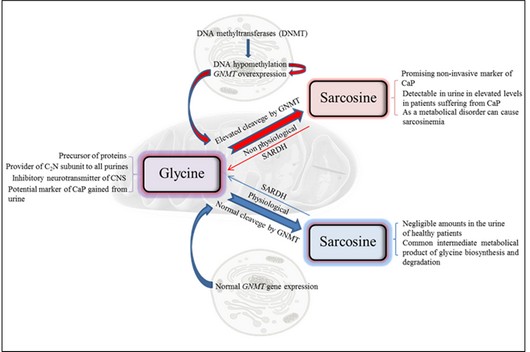

Dobrá díla jsou plodem dobrého charakteru a protože je chvályhodnější příčina než následek, chval více dobrý charakter bez vzdělání než vzdělance bez charakteru.
Leonardo da Vinci
Výzkum
Sarcosine as a potential prostate cancer biomarker
 Sarcosine, also known as N-methylglycine with the chemical formula CH3NHCH2COOH, was firstly isolated and named by German chemist Justus von Liebig in 1847. It is a non-proteinogenic amino acid that occurs as an intermediate product in the synthesis and degradation of amino acid glycine [1]. According to the Web of Knowledge database, there is an increasing incidence of keyword sarcosine as well as an increasing number of citations since 2009. This phenomenon confirms growing interest in sarcosine as a potential marker of a prostate cancer. The first publication describing the relationship between changes in level of sarcosine and progression of a prostate cancer was published in Nature by Sreekumar et al. in 2009 [1]. Since then sarcosine has been investigated as a new marker of prostate cancer by Issaq et al. [2] and has been identified as a metabolite greatly increasing during progression of a prostate cancer and metastatic process; which can be detected in urine [3].
Sarcosine, also known as N-methylglycine with the chemical formula CH3NHCH2COOH, was firstly isolated and named by German chemist Justus von Liebig in 1847. It is a non-proteinogenic amino acid that occurs as an intermediate product in the synthesis and degradation of amino acid glycine [1]. According to the Web of Knowledge database, there is an increasing incidence of keyword sarcosine as well as an increasing number of citations since 2009. This phenomenon confirms growing interest in sarcosine as a potential marker of a prostate cancer. The first publication describing the relationship between changes in level of sarcosine and progression of a prostate cancer was published in Nature by Sreekumar et al. in 2009 [1]. Since then sarcosine has been investigated as a new marker of prostate cancer by Issaq et al. [2] and has been identified as a metabolite greatly increasing during progression of a prostate cancer and metastatic process; which can be detected in urine [3].
The fact that sarcosine does not occur or occurs in negligible concentration in urine of healthy specimens is critical for its evaluation of potential disease marker [1]. This phenomenon reduces the risk of false positive and false negative results [4]. The possibility to use sarcosine as a marker of early stages of development of prostate cancer has been discussed in many papers [5-7]. Thanks to the application of sarcosine as a tumour marker, low cost analytical methods for its determination in the urine, tissue and blood plasma samples are being searched and developed. Biosynthesis of sarcosine has been shown to be certainly affected by the cancerogenesis (Fig. 1). This phenomenon was described by Mukherjee et al. whose, revealed an important role of glycine N-methyltransferase (GNMT) in the metabolism of tissues of prostate cancer [8]. It has been found that GNMT is involved in the metabolism of methionine as well as in the gluconeogenesis and transformation of sarcosine to glycine (Fig. 1). However, the role of sarcosine in carcinogenesis have not been fully understood and remains unknown, as indicate the results of the study published by Hakimi et al. [9]. Modulating the function of GNMT can be used to develop new strategies for treatment of prostate cancer. In addition, GNMT could serve as a new tumour marker to diagnose malignant progression of prostate cancer [10]. Nowadays prostatic antigen 3 (PCA 3) [11-13] and annexin (A3) [4,14-16] are the most widely used and generally accepted markers of non-invasive CaP in urine. There are also other newly discussed potential markers of CaP that may be useful in the diagnosis of progression of prostate cancer, which can be detected in urine, such as alpha-methylacyl-CoA racemase (AMACR) [17-19], which level is elevated in prostatic adenocarcinoma and high-grade intraepithelial neoplasia. The aim of this review is to describe the molecularly-biological aspects and biochemical pathways of biosynthesis of sarcosine and to summarize the basic data about suitability of chosen analytical techniques to determine sarcosine in various matrixes.
Barvy z laboratoře
 V naší laboratoři se již velmi dobře daří připravovat různé velikosti kvantových teček, které následně velmi krásně svítí. Na obrázku se můžeme kochat barevnou škálou získanou z kvantových teček kadmium-telur a ve výseku krásně zelené kadmium-selen.
V naší laboratoři se již velmi dobře daří připravovat různé velikosti kvantových teček, které následně velmi krásně svítí. Na obrázku se můžeme kochat barevnou škálou získanou z kvantových teček kadmium-telur a ve výseku krásně zelené kadmium-selen.
Plakáty k výzkumným směrům
Dokumenty pro VaV aktivity
Výzkumný záměr
Hodnocení výzkumných aktivit
Archív

 | Zemědělská 1/1665 613 00 Brno Budova D | Tel.: +420 545 133 350 Fax.: +420 545 212 044 |  |
 |




